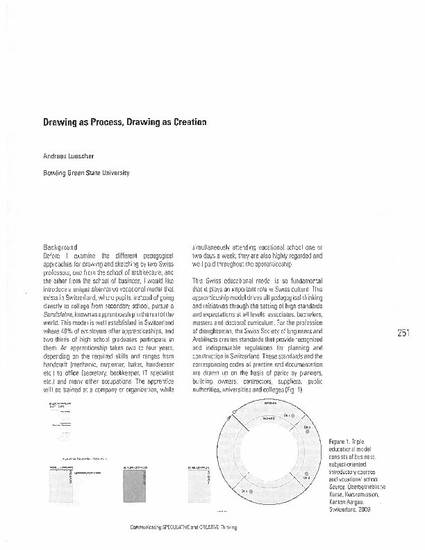
Presentation
Drawing as Process, Drawing as Creation.pdf
Biannual Conference of the Design Communication Association
(2016)
Abstract
In this paper I will examine the different pedgogical styles of two Swiss professors, one from the school of architecture, and the other from the school of business. Both educators practice teaching methods for creative thinking, underlined by techniques of representation through drawing and sketching. In this context, the terms drawing and sketching are used interchangeably as tools for knowledge construction and sharing. In the words of Peter Jenny, a Professor Emeritus and Chair of Visual Design at the ETH,one shouldn’t teach only drawing skills, but also visual perception and the joy of experimenting and using one’s imagination. In his two volumes Image Recipes (in German: Bildrezepte, 1996) and Image Concepts (in German: Bildkonzepte, 1996) Jenny explains didactically the aim of reasonable and free association in the process of organizing, forming and interpretating content, as well as engaging the senses through the process of motive assemblage. Martin Eppler, on the other hand, a Professor of Media and Communication Management at the University of St. Gallen, offers seminars on visual problem solving and collaboration. In Eppler’s book Sketching at work: A Guide to Visual Problem Solving and Communication (2010) the emphasis is on individual thinking as an interpretative process through articulating essential conventions, stimulating different viewpoints and extrapolating trends into the future. A precursor for both professors is Le Corbusier’s 1960 book, Creation Is a Patient Search, subtitled A Self-Portrait, in which he describes drawing as a continuum: observing—discovering—inventing—creating. Both Swiss educators believe through drawing our observations, we can discover the conceptual nature of design solutions, which in turn become the basis for our own creative inquiries into a record of thoughts, ideas and visions. It may sound simple, but it’s actually quite complex, because the act of drawing and sketching varies according to an individual’s personal style, visual thinking and imagination, and is also related to one’s context and culture.
Both educators see sketching as a form of auto-reflection that encourages the mirroring of events that may not be noticed by the conscious mind, and daydreams that occur frequently in different working and life settings. Within this commonality, differences still exist in Jenny and Eppler’s approach to teaching, driven by the understanding that architecture and business strategies and techniques are not inherently treated in a similar fashion in pursuit of innovation. I will conclude by examining the implications of these teaching methods for creative thinking as a source of imagination and inspiration.
Keywords
- Drawing,
- Sketching,
- Autoreflection,
- Strategies
Disciplines
Publication Date
Fall September 7, 2016
Location
Montana State University, Bozeman, MT
Citation Information
Andreas Luescher. "Drawing as Process, Drawing as Creation.pdf" Biannual Conference of the Design Communication Association (2016) Available at: http://works.bepress.com/andreas_luescher/14/
